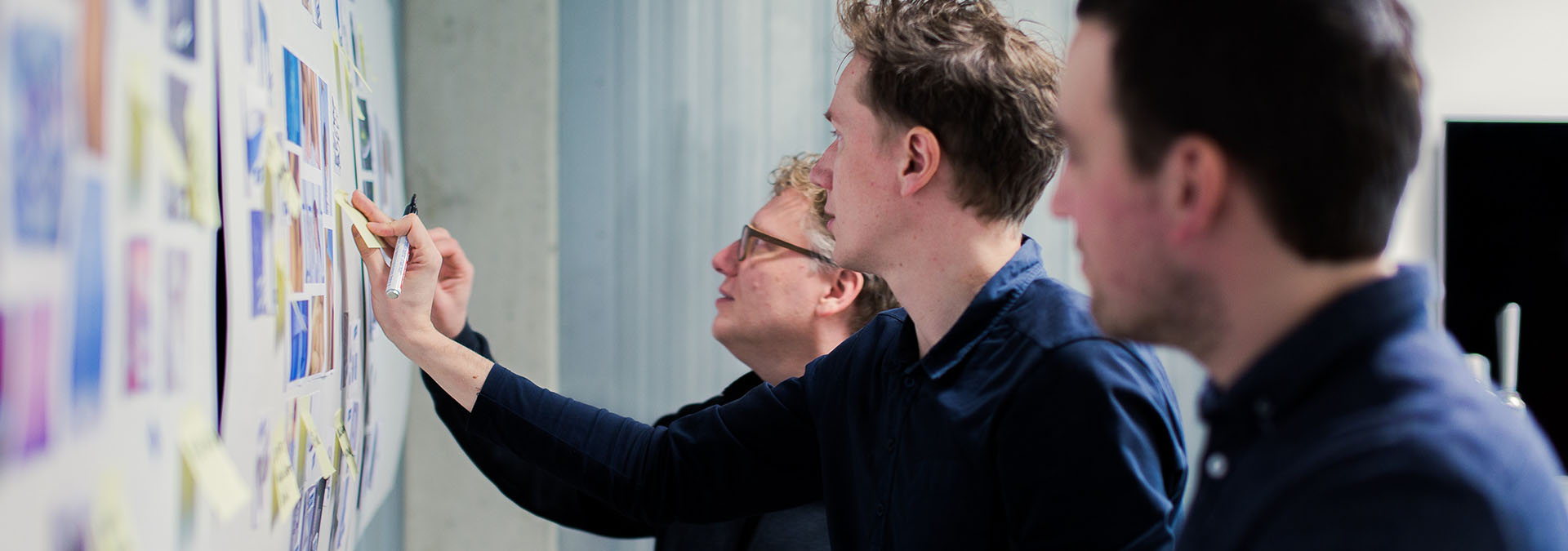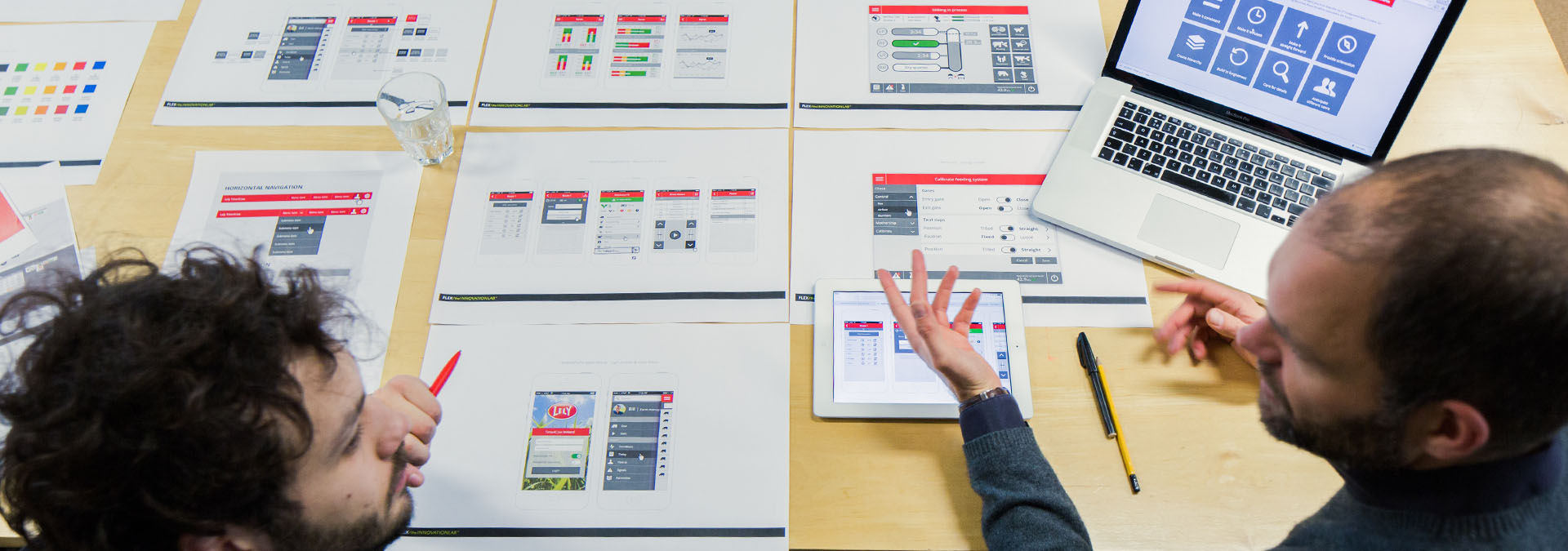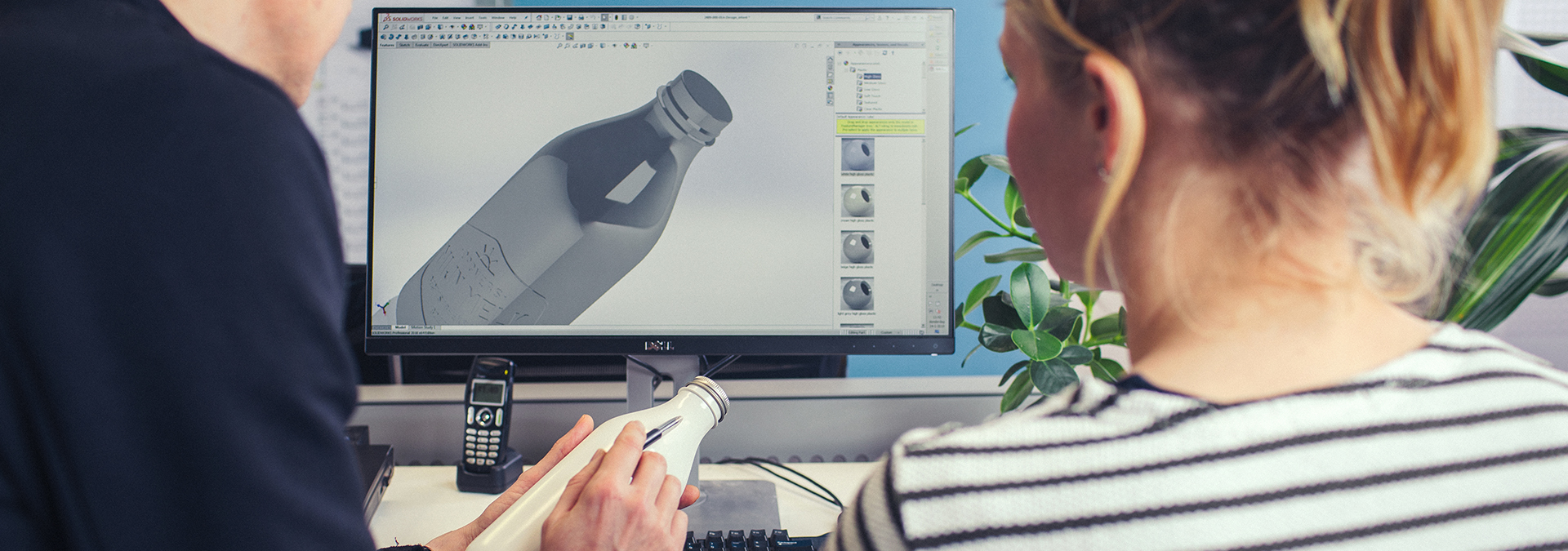




How we create tools and experiences that connect the dots between people, technology and business.

In-depth research is fundamental to creating products and services that respond to genuine human needs. To learn what really matters to your customers, we immerse ourselves in their world and listen to, observe and record everything they tell us. This ethnographic approach reveals their motivations, opinions, perceptions and expectations. Our design researchers painstakingly go through all this data to connect the dots between consumer insights, your brand and technological possibilities before presenting the results in clear, well-designed (what else would you expect?) formats.
It’s not just designers who have a say in the innovation process: consumers, distributors, retailers, manufacturers and brand owners all play an important role too. The best results come when these groups unite to work together on innovative solutions that everyone supports. Our co-creation tools (like the Designgame) allow us to manage this process efficiently and effectively for clients ranging from telecom giants to manufacturers of agricultural machinery.
In-depth research is fundamental to creating products and services that respond to genuine human needs. To learn what really matters to your customers, we immerse ourselves in their world and listen to, observe and record everything they tell us. This ethnographic approach reveals their motivations, opinions, perceptions and expectations. Our design researchers painstakingly go through all this data to connect the dots between consumer insights, your brand and technological possibilities before presenting the results in clear, well-designed (what else would you expect?) formats.
It’s not just designers who have a say in the innovation process: consumers, distributors, retailers, manufacturers and brand owners all play an important role too. The best results come when these groups unite to work together on innovative solutions that everyone supports. Our co-creation tools (like the Designgame) allow us to manage this process efficiently and effectively for clients ranging from telecom giants to manufacturers of agricultural machinery.
The seemingly endless possibilities that technology offers can be overwhelming. All the potential features that can be added to (connected) products and services may sound fantastic, but how do you know if something really adds a benefit to your customer? Or even if it’s something they actually want? That’s where our extensive toolset comes in. Together we connect the dots between consumer insights and technology to create design propositions that offer genuine value to you and your customers.
A modern brand needs to clearly communicate what it stands for – and there’s no more immediate touchpoint than a physical product and its packaging. We start by clarifying your brand story before developing suitable communication strategies for your brand values through the 3D appearance of your products. An array of materials, textures, colours, shapes, details and graphics will be explored as we work out the best way to tell your story best. The results are presented in easy-to-use guidelines that can be used by internal design departments to develop new products or judge external design efforts.
The seemingly endless possibilities that technology offers can be overwhelming. All the potential features that can be added to (connected) products and services may sound fantastic, but how do you know if something really adds a benefit to your customer? Or even if it’s something they actually want? That’s where our extensive toolset comes in. Together we connect the dots between consumer insights and technology to create design propositions that offer genuine value to you and your customers.
A modern brand needs to clearly communicate what it stands for – and there’s no more immediate touchpoint than a physical product and its packaging. We start by clarifying your brand story before developing suitable communication strategies for your brand values through the 3D appearance of your products. An array of materials, textures, colours, shapes, details and graphics will be explored as we work out the best way to tell your story best. The results are presented in easy-to-use guidelines that can be used by internal design departments to develop new products or judge external design efforts.
Nowadays people expect a customer journey to be a smooth, uniform experience. It might sound simple, but with today’s connected products there are countless interactions between brand and customer before, during and after an initial purchase. Our job is to seamlessly connect all these touchpoints and ensure that every interaction between customer and brand is carefully orchestrated.
To do this, our team of designers and researchers make detailed studies of customer journeys to ascertain points of friction and define opportunities for innovation. In the short-term, this creates happy customers, while in the long-term it establishes a platform for long-lasting, meaningful relationships between businesses and people.
Research shows that design-driven companies perform 20% better than companies in which design isn’t an integral part of their business strategy. With over 25 years’ experience of working for a wide range of clients, our strategists know exactly how to make design a valuable business asset and boost innovation and creativity in your organization.
We develop roadmaps that leverage current benefits and successes, tap into unmet client needs, and take advantage of emerging trends and technologies to improve performance in the current product lifecycle and beyond.
Nowadays people expect a customer journey to be a smooth, uniform experience. It might sound simple, but with today’s connected products there are countless interactions between brand and customer before, during and after an initial purchase. Our job is to seamlessly connect all these touchpoints and ensure that every interaction between customer and brand is carefully orchestrated.
To do this, our team of designers and researchers make detailed studies of customer journeys to ascertain points of friction and define opportunities for innovation. In the short-term, this creates happy customers, while in the long-term it establishes a platform for long-lasting, meaningful relationships between businesses and people.
Research shows that design-driven companies perform 20% better than companies in which design isn’t an integral part of their business strategy. With over 25 years’ experience of working for a wide range of clients, our strategists know exactly how to make design a valuable business asset and boost innovation and creativity in your organization.
We develop roadmaps that leverage current benefits and successes, tap into unmet client needs, and take advantage of emerging trends and technologies to improve performance in the current product lifecycle and beyond.

What are connected products? Well, they’re products with embedded data services that are connected to other products and systems via the Internet. And why are they worth knowing about? Because they offer incredible opportunities for innovation. Our designers can help you decide the best way to integrate these capabilities into your products and services.
We understand the potential and limitations of technology and can advise you on the operational implications. As it’s a rather complicated process, we make the connected experience tangible with our prototyping and visualization skills, and we seamlessly integrate product and UI/UX design too.
It’s very tempting to get caught up in the excitement surrounding the digital revolution, but you should never underestimate the value of the physical object. We believe in keeping an eye on the best of both worlds: as well as a clear picture of today’s technological landscape, we know what it takes to bring a product to market in industries ranging from agricultural machinery to food and beverages.
Our designers use consumer insights to develop objects that resonate with users on both a functional and emotional level and deliver on your business objectives.
What are connected products? Well, they’re products with embedded data services that are connected to other products and systems via the Internet. And why are they worth knowing about? Because they offer incredible opportunities for innovation. Our designers can help you decide the best way to integrate these capabilities into your products and services.
We understand the potential and limitations of technology and can advise you on the operational implications. As it’s a rather complicated process, we make the connected experience tangible with our prototyping and visualization skills, and we seamlessly integrate product and UI/UX design too.
It’s very tempting to get caught up in the excitement surrounding the digital revolution, but you should never underestimate the value of the physical object. We believe in keeping an eye on the best of both worlds: as well as a clear picture of today’s technological landscape, we know what it takes to bring a product to market in industries ranging from agricultural machinery to food and beverages.
Our designers use consumer insights to develop objects that resonate with users on both a functional and emotional level and deliver on your business objectives.
We bring embedded user interfaces and apps to life through intuitive digital design, from complex operating systems for farmers to simple controls for cookware and sport tracking devices. Our digital team develops meaningful interactions that surprise and engage end users, while boosting the brand experience. While we’re confident that we can do everything in-house, to ensure we offer you the full digital package, we also work closely with partners that specialize in augmented and virtual reality, web development and electronics.
A long, long time ago marketers used huge TV, radio and print campaigns to boost brands’ market position. Times have changed and audiences have moved, but product packaging remains a powerful and cost-effective way to tell a brand’s story. Structural packaging design helps brands grow, get noticed and much more – and in our experience, it can even change people’s behaviour, helping them to act more sustainably and eat healthier.
We bring embedded user interfaces and apps to life through intuitive digital design, from complex operating systems for farmers to simple controls for cookware and sport tracking devices. Our digital team develops meaningful interactions that surprise and engage end users, while boosting the brand experience. While we’re confident that we can do everything in-house, to ensure we offer you the full digital package, we also work closely with partners that specialize in augmented and virtual reality, web development and electronics.
A long, long time ago marketers used huge TV, radio and print campaigns to boost brands’ market position. Times have changed and audiences have moved, but product packaging remains a powerful and cost-effective way to tell a brand’s story. Structural packaging design helps brands grow, get noticed and much more – and in our experience, it can even change people’s behaviour, helping them to act more sustainably and eat healthier.
A prototype makes an idea tangible. When you’ve got something in your hands it’s much easier assess what it looks and feels like and how it might function. Fail fast, fail cheap is the motto as our designers and model makers whip up prototypes to get to the right result as fast and efficiently as possible. As well as quick mock-ups, super detailed show models and working prototypes, we prototype connected product experiences with the latest popular board and development platforms, while for user interfaces we turn to interactive wireframe software and mock-up tools.
Sometimes innovation challenges demand a closer collaboration between the in-house development department and our specialists. When this happens, our designers and engineers work on-site to boost the client’s creative or engineering potential. It’s a win-win situation, as our clients get what they want, and our specialists involved get to connect with and learn from their new colleagues, forging a better and closer relationship.
A prototype makes an idea tangible. When you’ve got something in your hands it’s much easier assess what it looks and feels like and how it might function. Fail fast, fail cheap is the motto as our designers and model makers whip up prototypes to get to the right result as fast and efficiently as possible. As well as quick mock-ups, super detailed show models and working prototypes, we prototype connected product experiences with the latest popular board and development platforms, while for user interfaces we turn to interactive wireframe software and mock-up tools.
Sometimes innovation challenges demand a closer collaboration between the in-house development department and our specialists. When this happens, our designers and engineers work on-site to boost the client’s creative or engineering potential. It’s a win-win situation, as our clients get what they want, and our specialists involved get to connect with and learn from their new colleagues, forging a better and closer relationship.

No innovation comes without risk. Is the target cost price realistic? Do all the functional elements perform as desired? Thanks to years of hands-on experience introducing products into the market we know how to successfully manage and reduce these risks and more. Our engineers safeguard the design intent within the realities of costs, manufacturing, supply chains and digital platforms. We do this for simple and hyper-complex products by using advanced CAD and CAE tools such as PTC Creo and carrying out FEM analysis with Ansys.
‘Details are not the details, they make the design’, said Charles Eames. We can’t help but agree. How and by whom products and parts are manufactured has a huge impact on the overall quality. That’s why we have a vast network of expert suppliers and partners (in both the physical and digital realm) that are the best fit for your manufacturing needs. As if that wasn’t enough, our engineers will stand beside you throughout the manufacturing process to ensure a smooth transition from design to production.
No innovation comes without risk. Is the target cost price realistic? Do all the functional elements perform as desired? Thanks to years of hands-on experience introducing products into the market we know how to successfully manage and reduce these risks and more. Our engineers safeguard the design intent within the realities of costs, manufacturing, supply chains and digital platforms. We do this for simple and hyper-complex products by using advanced CAD and CAE tools such as PTC Creo and carrying out FEM analysis with Ansys.
‘Details are not the details, they make the design’, said Charles Eames. We can’t help but agree. How and by whom products and parts are manufactured has a huge impact on the overall quality. That’s why we have a vast network of expert suppliers and partners (in both the physical and digital realm) that are the best fit for your manufacturing needs. As if that wasn’t enough, our engineers will stand beside you throughout the manufacturing process to ensure a smooth transition from design to production.
Validating at an early stage how our ideas and designs work in real life is an essential step in reducing risk. We help you to ensure that there will be no surprises in production or in use, whether it’s a digital or physical product or service. To make sure everything’s shipshape we use 3D CAD models to analyse stress and strength in FEM analysis, and build (and test) prototypes that perform exactly like the real product.
Our many years’ experience of working closely together with clients has given us a deep understanding of the challenges they face – which in turn means that we can confidently offer turn-key projects. In doing this we can take the burden off your shoulders, as we become co-developers. This is how the seedling trays for Florensis, a large grower from Hendrik-Ido-Ambacht were developed: we took care of the development process from the first idea to the production and usage of thousands of trays.
Validating at an early stage how our ideas and designs work in real life is an essential step in reducing risk. We help you to ensure that there will be no surprises in production or in use, whether it’s a digital or physical product or service. To make sure everything’s shipshape we use 3D CAD models to analyse stress and strength in FEM analysis, and build (and test) prototypes that perform exactly like the real product.
Our many years’ experience of working closely together with clients has given us a deep understanding of the challenges they face – which in turn means that we can confidently offer turn-key projects. In doing this we can take the burden off your shoulders, as we become co-developers. This is how the seedling trays for Florensis, a large grower from Hendrik-Ido-Ambacht were developed: we took care of the development process from the first idea to the production and usage of thousands of trays.